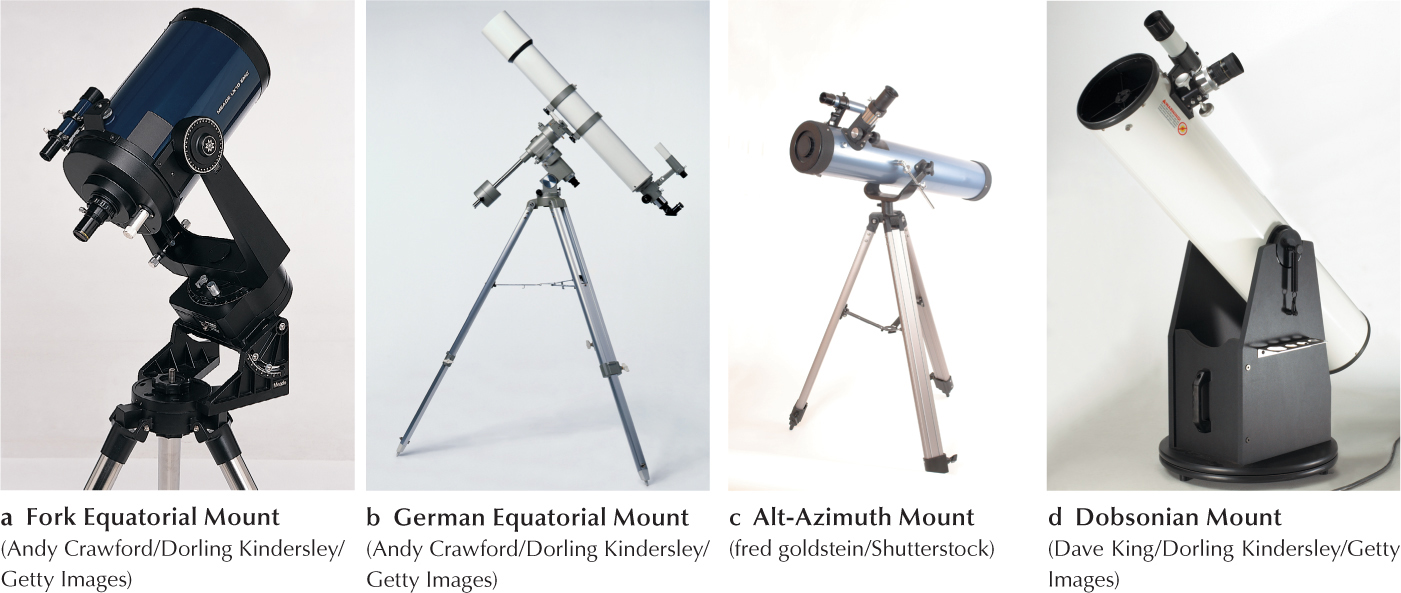Appendix H: Buying A Telescope
If you feel elated by discovering treasures, you may want to consider viewing the night sky through powerful binoculars or a telescope. Both types of instrument enable you to find many beautiful, exciting objects in space. Binoculars are nice because you can quickly scan the heavens to see craters on the Moon, star clusters, the Great Nebula of Orion, and even the Andromeda Galaxy. Telescopes open new vistas and even allow amateur astronomers to discover new comets, among other things, adding to our scientific database and immortalizing the discoverers’ names.
There are four basic types of telescope mounts that steer telescopes around the sky as shown in Figure 1a-d: the Fork Equatorial Mount, the German Equatorial Mount, the Altitude−Azimuth (Alt−Azimuth) Mount, and the Dobsonian Mount (see figures). Table H-1 presents the advantages and disadvantages of each mount.
Reflecting and refracting telescopes both have pros and cons, as discussed in the text. Refractors and Newtonian reflectors tend to be longer and bulkier than any other types. Newtonians are the least expensive and simplest telescopes to build. As a result, they are often used with the inexpensive Dobsonian mounts. If you plan to take photographs, a Cassegrain telescope is the best instrument because it remains balanced as the telescope tracks objects across the sky.
If you want to see especially large areas of the sky, you may want to purchase a telescope with a Schmidt corrector plate. The most common wide-field telescopes are of the Schmidt-Cassegrain design. These telescopes have a Schmidt corrector plate on top and a Cassegrain mirror on the bottom, with their eyepieces located underneath.
If you build or buy a telescope with the eyepiece positioned so that you have to crawl under it or climb a ladder to see through it, you will find the experience less satisfying than if you can observe from a more comfortable position. If the eyepiece is not easily accessible, you can buy a diagonal mirror (a right−angle mirror that goes between the telescope body and the eyepiece) to help correct this problem.
You will also want to get a few different eyepieces with different focal lengths (three is a good number to start with), so that you can look at large areas of the sky under low magnification and details of small areas under high magnification. As discussed in the text, the magnification of a telescope depends on the focal lengths of the objective lens (or primary mirror) and the eyepiece. The objective lens or primary mirror is fixed in the telescope. However, all telescopes come with removable eyepieces. Change the eyepiece to another of different focal length, and you can change the telescope’s magnification. Keep in mind, however, that increasing the magnification decreases the area of the sky that you see.
Unless your telescope is computerized, it is also essential to have a finder scope, which is a small, lowmagnification, very-wide-field telescope, with crosshairs, attached directly onto your main telescope. If the finder and your main scope are well aligned, you can quickly zero in on an object.
If you plan to take photographs with a CCD camera or other instrument on your telescope or to show the cosmos to large groups of people, you will need a tracking motor to enable the telescope to follow the stars automatically. Tracking motors require their own power from internal batteries, from a 12-volt outlet in a car, or from a 110-volt outlet. The motor should also be able to run at high speed so you can slew (turn the telescope rapidly) from one object to the next. For photography, you will also need a camera adapter.

A-21
Viewing the Sun is very exciting, especially when you can observe sunspots. If you want to observe the Sun, it is essential that you buy a good Sun filter. Never, ever look at the Sun directly, either through a telescope or with your naked eye. Doing so for even a second can lead to partial blindness!
Finally, you will need a flashlight with a red plastic film over the lens or one with a red LED light. Because red light does not cause the pupils of your eyes to contract, they will remain dilated (wide open) while you use the red flashlight to inspect your equipment and your star charts.
| Type of Telescope | Pros | Cons |
|---|---|---|
| Fork Equatorial |
|
|
| German Equatorial |
|
|
| Alt-Azimuth |
|
|
| Dobsonian |
|
|
A-22